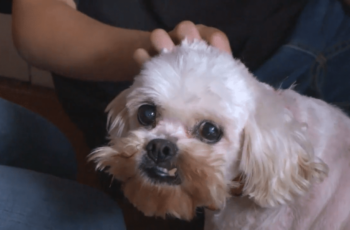https://youtu.be/PtVVYSwjp74
Have you ever wondered if your dog’s wagging tail means anything? Is it their way of communicating? Here are twenty possible answers.
20 Reasons Why Dogs Wag their Tail
1. The Meaning of a dog wagging its tail.
Wagging tails can seem like nothing more than an innocent, happy gesture. But believe it or not, there’s a lot that you can tell about the dog just from the way they wag their tail! For example, when dogs are excited, they tend to do this side-to-side motion. When they are alert or being aggressive to another animal, on the other hand, they will hold their tail high and thready. If a dog wags their tail quickly, this is usually a sign of happiness.
2. Tail wagging is conscious and subconscious behavior.
While some dogs tend to twitch their tails on their own without realizing it, most dogs are very aware of the cute little tails that dangle behind them. They can use the tail as an additional way to communicate with both humans and other animals. For example, puppies will often wag their tails playfully around people. This shows that they are happy to see the person. On the other hand, when a dog is very excited, it will make this side-to-side motion. This is simply another way of showing excitement or happiness.
3. Dogs wag their tails to communicate.
These tiny appendages are not just for show! Dogs use their tail to communicate with each other and humans too! For example, if you approach a dog while sleeping, you may notice that he will twitch his tail right before opening his eyes. This is because his tail acts as an indicator of his level of interest. If the tail is fully extended, he is much more likely to open his eyes, and if he starts to wag the tail, he will begin to become more alert.
Dogs wag their tails when they are happy, excited, and content. They may also start to wag quickly when excited and scared. Dogs may also begin to shake or jiggle their tail if they are angry or frustrated with you, as well as if they have just been taught some new trick that has made them happy. The tail may also be wagging because of a fight that just ended or an argument just starting.
4. Different dog breeds tend to wag their tails.
Many different breeds of dogs have been bred for various purposes. German Shepherds are famous for being extremely loyal, especially when they have been well trained as a guard. These dogs are known for their very thick, heavy tails. They are very useful in keeping the dog’s balance when it is running or walking at a fast pace.
5. Dogs wag their tails when they are feeling threatened.
If a dog feels threatened by another animal, he will often hold his tail high in the air. This will warn all other animals that may be present that he is not happy.
6. Tail wagging an innate behavior for dogs.
While most dogs can wag their tail independently, some breeds, like the German Shepherds, are known to wag their tails when they feel threatened. This is a reflexive behavior that is innate in them, and it does not require them to be aware of it to do so.
7. Dogs wag their tails when they are happy.
Even people who have never spent much time around dogs know that a wagging tail means that the dog is happy. This may seem like a simple concept, but many people don’t understand why this happens. This is because dogs are pack animals, and they are very comfortable around other animals they trust. When they see another dog or even a human, they will often wag their tails.
The natural tendency of dogs is to wag their tail when they are feeling happy. This is an innate behavior that most dogs have no control over. It is a reflexive behavior that does not require any mental process to perform. For this reason, scientists and researchers have been able to use this information to measure the happiness of animals to determine whether or not they are happy, sad, or scared.
8. Dogs’ tail wagging rate be related to a dogs’ breed.
While some dogs will twitch their tails on their own, the real indicator of tail wagging is the rate at which they move. For example, when a dog is very happy or excited, it will often wag its tail quickly. On the other hand, when they are feeling threatened or scared, they will hold the tail high and tight to their body. This is often referred to as an angry dog.
9. Dogs wag their tails when they are feeling aggressive.
Many people think that a dog that is wagging its tail is friendly, but this is not always the case. Dogs will often hold their tails high when they feel threatened by another animal to ward it off or scare it away. If a dog feels threatened by you, he may start to thready his tail. This will show you that he is not happy and that you should back away slowly.
10. Dogs wag their tail more when they see humans.
There are several reasons why dogs will start to wag their tails more when they see a human. Dogs are very social animals and have been domesticated for thousands of years. For this reason, it is very easy for them to bond with humans. Dogs will often wag their tails when they see humans because they want attention from interacting with another animal.
11. Dogs wag their tails when they are scared.
Most dogs prefer to stay away from any conflict. This means that a dog may often wag his tail when he is feeling threatened. Dogs will tend to thready their tail when they feel scared or threatened by another animal because it gives them time to assess the situation and figure out how they want to handle it. The position of the tail is often an indicator of how the dog is feeling too. For example, if the tail is lowered and wagging slowly, it is an indicator of submission. A dog will do this to show that he is not comfortable with the situation.
12. Dogs wag their tails when they are smelling an object.
Dogs can smell the air through the use of an organ in their nose called a vomeronasal organ. When a dog smells something, it will hold its tail reasonably still. This is a subconscious behavior that most dogs do on their own. This is also an indication that they are interested in whatever is being smelled. Dogs will often wag their tails for animals that they are mating with or greeting.
13. Dogs wag their tails while sniffing the ground.
While many dogs will not necessarily wag their tails when they sniff something, a few breeds have been bred to use this technique when they are hunting. For example, Labradors have been trained to sniff the ground when they are hunting. If you have a Labrador Retriever and you want him to take on a task, you can ask him to hunt for an object by tapping it with your foot or maybe even throwing an object into the grass.
14. Dogs wag their tails when they are in pain.
It is well known that dogs can be very stoic and tend not to show their pain. This can make it difficult for owners to know when their dog is feeling pain. One of the things that they do when they are in pain is to thread their tail. For example, if a dog falls hard on his back, he may hold his tail tight and start to thread it as a way to deal with the pain.
15. Dogs wag their tails when they greet humans.
Dogs, like humans, form relationships based on trust. Dogs cannot just communicate these emotions to you verbally; it is simply too hard for them to express themselves in this way. However, they can show you that they are happy to see you by wagging their tail. This is a way of showing that they want to be close to you and that they want to spend some time with you.
16. Dogs wag their tails when they meet new people.
Dogs form new relationships very quickly. For this reason, they will often start wagging their tails when they meet a new person. This is especially true when the dog has formed positive experiences with people in the past. For example, if a dog has been to a veterinarian and had a good experience, he will often wag his tail when he sees a human because it brings back nice memories of that time together.
17. Dogs wag their tails for food.
Their instincts drive dogs, and through these instincts, they can be trained to act in specific ways. Dogs trained to associate a particular smell or sound with something goodwill often react by wagging their tail. For example, every time a certain door opens, your dog may come running because there is food on the other side. This indicates that he associates the sound of the door opening with the treat he is about to receive.
18. Dogs wag their tails in their sleep.
Dogs are capable of reacting to things they see, hear, and smell while sleeping. For example, if you go into the other room and a door opens or closes, your dog may start to bark or whine because he has heard the sound. If this happens just before or during a dream, he will often wag his tail as well. This indicates that the dog is dreaming of something positive and that he is happy about it.
19. Dogs also wag their tails when they are attempting to establish dominance.
If the wagging is accompanied by other typical dog behaviors, such as an erect and standing body position and a growling sound, the dog communicates a dominant role.
This type of wagging is usually faster initially and then slows down as the target starts to submit. A dog can establish dominance over another dog, human, or animal.
20. Dogs wag their tails when they find something interesting.
If there is more of an alert stance with ears cocked forward and tail wagging slowly, the dog lets you know it has found something interesting.
Dogs wag their tails when they are investigating something interesting or new. They may also start to wag their tail as a way of asking for more attention or affection.
In Summary
Dogs wag their tails when they are happy when they feel excited, or feel threatened, or also when nervous or fearful about something.
What do you think?
Now that you know how to understand dog wagging tail share this information with others and let them know what you have learned. Hopefully, there will be many exciting ideas about dog wagging tails out there, and maybe there will be some new facts and explanations about the topic.


